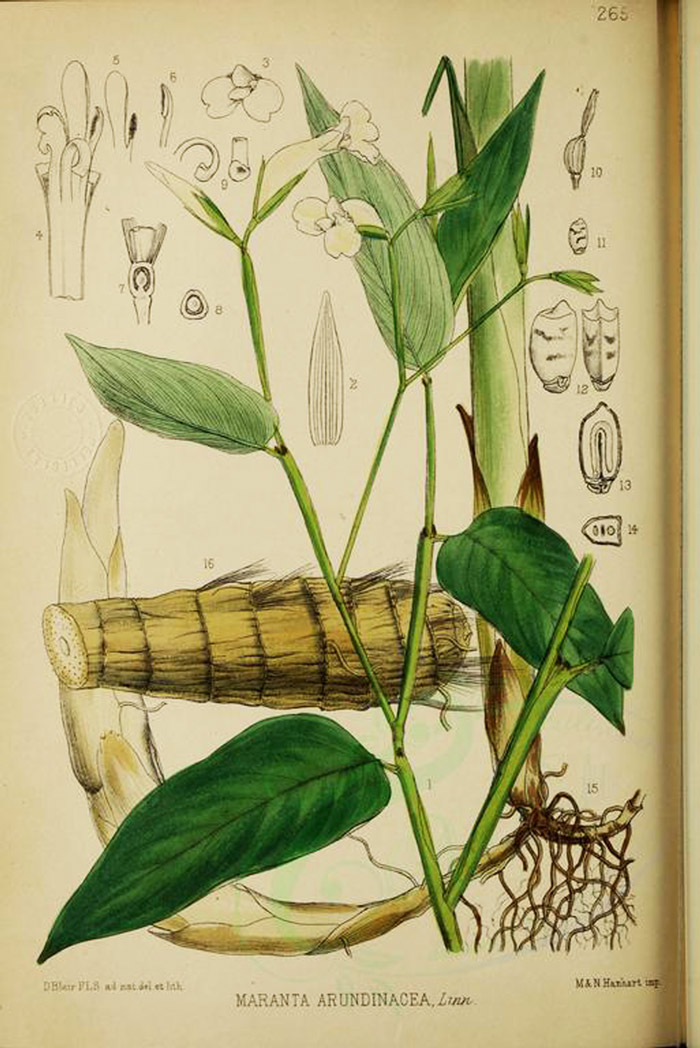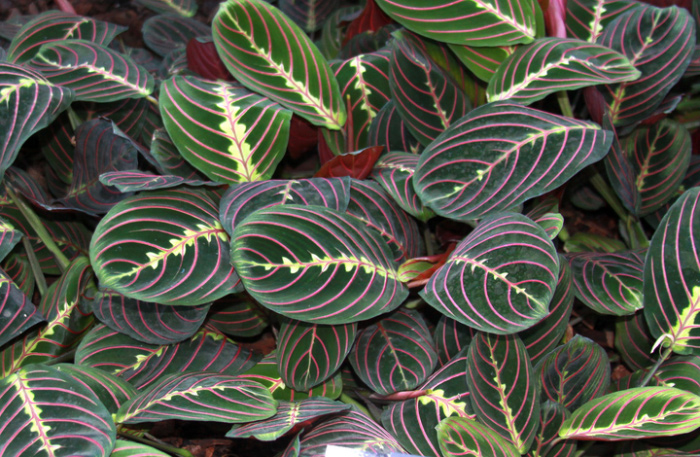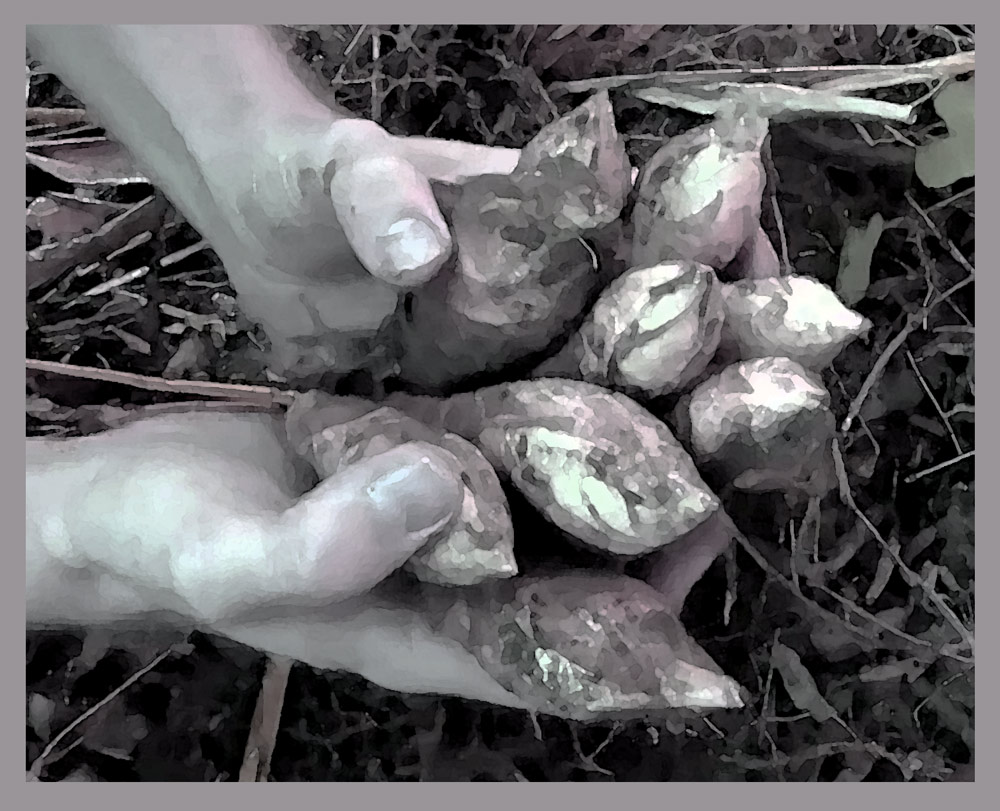 Growing arrowroot is very, very easy.
Growing arrowroot is very, very easy.
That said, I only mention the crop in passing in my book Totally Crazy Easy Florida Gardening because of the processing it takes to actually eat it without getting a mouthful of fibers. All I write is:
“Arrowroot is very easy to grow and beautiful to look at, but the yields are small. Roots require extra processing. It’s good as a non-recognizable background sort of survival crop if you’re worried about the end of the world and someone stealing your sweet potatoes… but not really much of a staple.” -Totally Crazy Easy Florida Gardening, Chap. 6
Though the young roots don’t only contain some fibrous strings, the older roots are basically inedible… except for their starch. So how do you harvest the starch out of arrowroot? Here’s a good post.
I’ll probably make arrowroot flour at some point myself; however, it’s not high on my priority list, particularly since I can just grow huge piles of yams instead with much less work.
Despite that fact, I really love growing arrowroot as an attractive member of the herbaceous layer in my food forest.
A couple of days ago I recorded a video on growing arrowroot and dug up one of my plants to harvest the roots. Check it out:
Even if you weren’t growing arrowroot for the starch, it would be worth growing because it’s such an attractive and care-free plant.
The video doesn’t do it justice since it’s entering the dormant season and dying back. They’re a lot prettier in the spring. Here’s all you need to do to start growing arrowroot in your own garden.
Growing Arrowroot
Arrowroot, or as its friends call it, Maranta arundinacea, is a tropical plant with some quite beautiful variations as well as some attractive cousins you’ve likely seen for sale as houseplants.

Maranta leuconeura. Photo credit Drew Avery. CC license.
Though some sources report that growing arrowroot requires shade, I’ve had it do well in almost full sun along the path in the center of my food forest.
I’ve grown it in full shade as well, though that plant was less productive. Half-sun seems to be the sweet spot. If you get good rainfall and have decent soil, the yields increase. My arrowroot plants are fed with nothing but rotting wood chip mulch from the power company tree trimmers and that’s been enough for them to produce decent yields of roots. I pulled one from a rich and moist garden bed and got about 4 times the roots from it as from the one in the video above. Location, location, location!
That said, they really are a low-care perennial.
When to Harvest Arrowroot
When you’re growing arrowroot and it starts to die in the fall, don’t fear. It’s just going into dormancy. They’ll freeze to the ground in winter and come back again in the spring, much like ginger.

That’s the time I pull the roots. Give them a year of growth and they’ll usually make at least a half-dozen or more harvestable roots. Give them two years and you’ll get a lot more than that.
Where To Buy Arrowroot Plants
I got my arrowroot starts from Grower Jim and I recommend him as a source. That link will take you to his write-up on growing arrowroot and there’s a link at the bottom of his article where you can order roots.
Is it Worth Growing Arrowroot?
As a survival crop, arrowroot has the advantage of being basically unknown, making it invisible to thieves. On the down side, it’s not the best to eat fresh due to its many fibers.
That said, I’ve eaten the raw roots by chewing them up and spitting out the fibers. The starch has a cool, smooth flavor that’s rather refreshing. It’s also quite digestible. You may not enjoy eating arrowroot like you’d enjoy eating Idaho potatoes, but they could keep you fed if everything fell apart.
SPUDOMETER RATING: 3.5 Spuds!

Name: Arrowroot
Latin Name: Maranta arundinacea
Type: Herbaceous perennial
Nitrogen Fixer: No
Medicinal: Some reports on helping digestion
Cold-hardy: Dieback perennial
Exposure: 3/4 sun to shade
Part Used: Roots
Propagation: Roots
Taste: Unoffensive
Storability: Great in ground, good in the fridge
Ease of growing: Very easy
Nutrition: Low
Recognizability: Low
Availability: Low


29 comments
I plan on experimenting with a food mill. I think it could possibly separate the fiber from canna edulis roots, pindo palm fruit…and perhaps arrow root, (boiling roots until soft before attempting to mill.) If I ever get enough to harvest, I will post my results.
I too, am completely in love with yams (Dioscorea alata) as far as taste, productivity, and ease of growing, but surprisingly, have found them rather difficult to propagate. My beautiful purple ube yams grow like mad, but rarely set air bulbils, and I have never been able to root a cutting. Carefully dividing the crown each winter seems like a ridiculously slow means of propagation….maybe you or a fellow reader will have some suggestions to seep things along?
You might find some inspiration in my big new yam post: http://www.thesurvivalgardener.com/how-to-grow-yams/
We live in zone 8b. We grew ube last summer. I bought a few at the Asian store in town. Chopped them into small chunks, soaked them in a mixture of wood ash and water, and buried them in the garden. After a few weeks the vines popped up and started growing in all directions. They were wildly successful. In the fall we harvested them. We cooked with some and saved a few to start again in the spring.
This is great. What a good experiment.
After three years of meager cassava harvests I am moving my cassava bed out front in more sun, and I’m planting arrowroot and taro in the cassava bed. The arrowroot will have to duke it out with the sword fern. Wish me luck!
That ought to up the cassava yields significantly.
And…. luck!
DTG, I enjoyed your introduction to Arrowroot & will try to get some from Grower Jim. It sounds like we can grow it as an annual here in Salt Lake City
I’m not sure but it would be a great experiment!
Hi just wanted to know if the leaves are able to be eaten by cattle. I run a dairy farm and am always looking for fodder that will help in the production of milk supply without adding all those pesky products to their diets. An old timer told me once that arrowroot was good for milk production but I have never known if they have to eat the bulbs or if I could feed off the leaves as a pasture crop? Also if I was to plant up a paddock of arrowroot where could I obtain that quantity of bulbs and like some other pastures such as clover, can I overfeed the cattle detrimental to their health?
It is safe. There is some good data on arrowroot as a ruminant feed here: http://www.feedipedia.org/node/545
Have you looked into comfrey leaves as a milk stimulant for cows. It’s supposed to work exceptionally well.
No, I have not. Never had much luck growing comfrey in warm climates and I haven’t raised cattle.
I knew I had seen this plant discussed in your website, so when I found it available on line, I didn’t think twice and bought it (it is hard to find in this part of the world).
I should have re-read your article before buying, because the processing is too long to make it a staple crop, especially in here (zone 8_something). ;-)
As my gardening skills are way beyond what I’d like them to be, this plant may die before I can harvest anything.
Anyway, thanks a lot for the information.
They should grow well. And actually, you don’t really have to process them all that much to eat. Only if you want flour. I still think they’re worth tucking into the landscaping.
Can arrowroot be grown in zone 8a ? I am in the McDonough area , about 40 miles south of Atlanta Georgia. I already successfully overwinter Pomegranates, and Ruellia [ Mexican Petunia ] , and most if not all of the Lantanas here. I have also seen Brugmansias and Bananas here.
Everyone mentions this being a tropical plant, but you suggest is can withstand a freeze… with no further explanation.
Yes, it does because they lived in my food forest, which was subjected to as much as 20 degrees below freezing. The leaves don’t live but the roots will beneath the ground.
This is not about growing. It is about harvesting.
How to begin? To have stems and propagate using those?
If you can get a root and plant it, they will shoot up and start making a clump. An existing clump can be divided. When they die down to the ground is the best time to harvest roots, which can also all be planted out.
I’m in the temperate zone of Sydney. QLD arrowroot grows amazingly well. I’ve just dug up a few bulbs to add to the stock pot. Parsley roots add an amzing flavour to stock!
Nice! I love parsley.
My arrowroot plant is growing in a large container for nearly 2 years, I don’t know when to harvest, the leaves have never turned yellow or died back( i live in tropics).
I would dig some up and see what you have.
A better arrowroot (in my opinion, but feel free to completely disagree, lols) to grow is Queensland Arrowroot, Cannus Edulis. It’s an EXCELLENT addition to fetid swamp water, lols- I know you like Leucaena, but it’s a terribly invasive species where I live, and our native landscapes suffer enough with weeds. Comfrey just DOES NOT grow where I live- far too hot and humid, it’s a pathetic grower, and I really can only grow it as an anual over autumn/winter. Qld Arrowroot, though, grows year round, the yound tubers are YUM, I can get starch for my cooking from older tubers (less reliance on stores for thickening agents), it produces hard enough to do a regular chop and drop for mulch or compost dump, can be divided regularly, leaves are nutritious for animal feed, and it acts like comfrey when added to compost and weed teas- really kicks things off nicely with good potassium levels as well. Creates amazing shade, as well. Definitely, if you’re thinking of adding arrowroot in your garden, grow Cannus Edulis!!
I have heard good things about it but have not been able to find tubers, other than the pretty cultivated flower types. They are a great chop-and-drop, though. Good addition – thank you!
[…] Why You Should Keep Mango Trees Small and… Velvet Beans: A Natural Testosterone Booster Growing Arrowroot What is the Best Wood Finish for Tool… The Top 5 Best Garden Hoes The Edible Blue Mushroom: […]
[…] nonbusbus thinks so, commenting on my article on growing arrowroot: […]
Can I please have some to grow, these are my childhood snacks in Vietnam. I am searching to buy some to plant in my garden. Can I buy some from you please?
I forgot to mention, the arrow roots are the one I am desperately seeking for. I also know there also a red kind of arrowroot, if I can get both kinds will be great. Thank you for your videos about this.
Comments are closed.